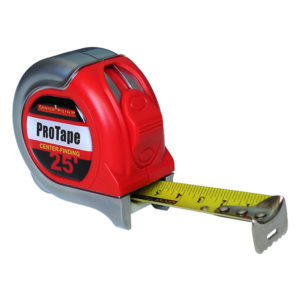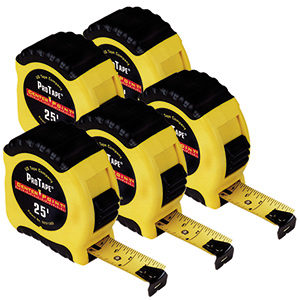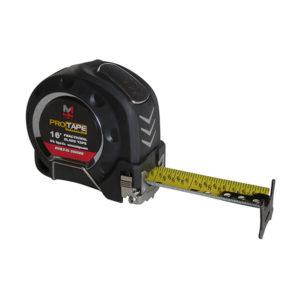
A tool is only as good as the person using it.
That’s an old saying, but a true one, and something that applies to tape measures as well. They’re only effective if the person using them knows how to get an accurate reading.
In this blog post, we’re going to look at how to accurately read a tape measure.
ESSENTIAL FEATURES
Let’s begin by reviewing the essential parts of an “Imperial” or “English” tape measure:
1. INCH DESIGNATIONS
On a tape measure that uses imperial units – as opposed to the metric system – the most prominent markings are typically the inch marks, designated by long, thin lines and larger numbers. You will see a foot designation marked every 12 inches (sometimes in a box as in the picture, or sometimes the number will be shown in red).

2. HALF INCHES
Half-inch marks sit between two one-inch marks. Depending on the tape measure, these may not be designated with a number, which means you’ll need the markings on either side to guide you. In other words, the half-inch mark between inches 13 and 14 is read as 13 ½ inches, and sits exactly midway between the markings for those numbers.
3. QUARTER INCHES, EIGHTH INCHES, AND SIXTEENTH INCHES
Most standard tape measures in the U.S. have markings that measure down to 1/16 of an inch. These are smaller, sometimes thinner markings, evenly spaced between the half-inch and inch marks on a tape measure. On some tapes, quarter inch marks are the same size as eighth-inch marks. Remember that two sixteenths of an inch equals one eighth, two eighths of an inch equals one quarter, and 2 quarters equals one half. For example, the second eighth-inch marking after the inch marking is a quarter inch.
4. FRACTIONAL-READ TAPE MEASURES
Some tape measures make it easier to decipher the markings by calling out the fractional equivalents right on the face of the blade. These are known as ‘Fractional Read’ or ‘Easy Read’ blades. Most will show fractions down to eighths of an inch.
5. METRIC TAPE MEASURES
On a metric tape you will basically see markings for meters, centimeters, and millimeters. Numbers shown represent meters, decimeters (sometimes shown in red-see example picture), and centimeters. Metric is based on ‘tens’. There are 10 decimeters in a meter, 10 centimeters in a decimeter, and 10 millimeters in a centimeter.

If you have a metric tape measure, the numbers should be read like this:
- The large, numbered markings are centimeters
- There is a smaller marking exactly halfway between the centimeters for ease of reading
- The smallest markings are millimeters, or one tenth of a centimeter
Looking at the example, if you measure something past the 28th centimeter marking to the third millimeter, you would say it measures 28.3 centimeters long.
TAKING A MEASUREMENT
When using a retractable tape measure, you’ll have a small metal hook at the end of the tape, which you can use to grab onto the edge of what you are measuring to hold the blade in place.
If you aren’t measuring something you can latch onto – the distance across a door frame, for example – press the hook against one side to ensure an accurate reading.
With the hook pressed in place, pull the tape blade out until it spans the distance you’re measuring. Keep the tape straight. If it sags, your measurement will be off.
Once you’ve gotten the tape where you need it to be, take the measurement directly from the tape.
Looking for a quality, accurate tape measure? U.S. Tape can help. Visit our website today to find the tape measure that’s right for your next job.



